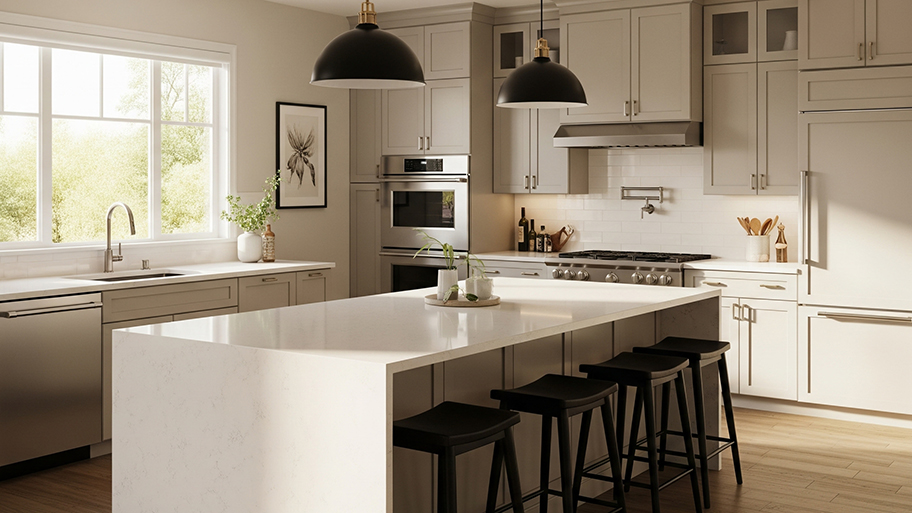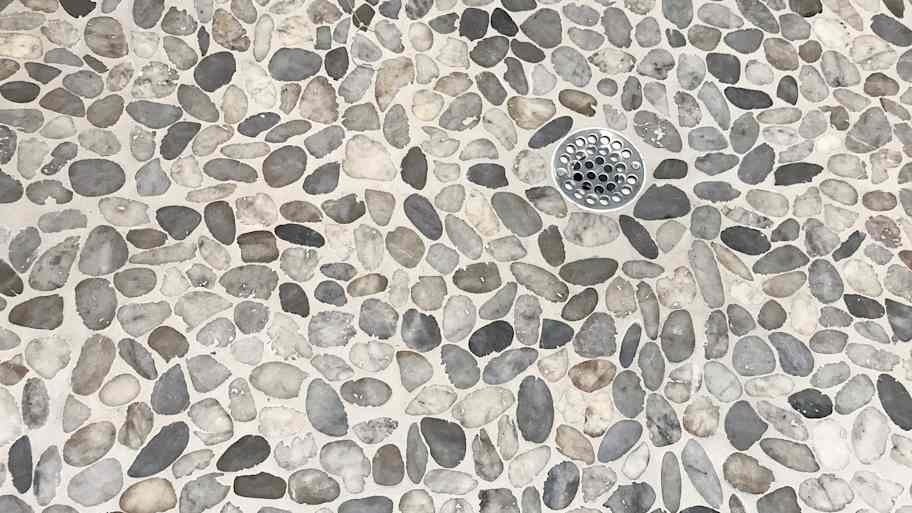
Marble backsplashes are beautiful and costly additions to your kitchen. Our guide lays out marble options and the labor required to install it.
Cultured marble costs an average of $1,850, with most homeowners spending between $1,280 and $2,180 on average. Prices depend on project size, type, labor, and customization.


Cultured marble costs depend on project size, type, and customization are the biggest cost drivers.
Cultured marble is a versatile, budget-friendly alternative to natural stone.
Labor rates range from $40 to $100 per hour for professional installation.
Expect to spend $30 to $100 per square foot for cultured marble.
Cultured marble upgrades offer a 50% to 70% ROI.
This article was created using automation technology and thoroughly fact-checked and edited by an Angi Editor in accordance with our AI policy.
Cultured marble costs an average of $1,280 and $2,180 for a standard installation, with most homeowners paying an average of $1,850. Prices range from $30 to $100 per square foot, depending on the size and complexity of your project. Whether you’re installing a new vanity top, shower, or tub surround, understanding these costs helps you budget confidently.
Cultured marble is popular for its style, affordability, and easy upkeep. Knowing what affects cultured marble cost allows you to plan your remodel, compare options, and get the best value for your home.
The size of your cultured marble project is one of the most significant factors affecting cost. Larger installations require more material and labor, while smaller projects may still incur minimum order or fabrication fees. Standard sizes exist for common applications like vanity tops and shower surrounds, but custom dimensions can increase the price.
If you’re planning a bathroom remodel, expect to see different prices for a single vanity top versus an expansive shower surround. Minimum order requirements from fabricators may also influence your final cultured marble cost, especially for small projects.
| Project Type | Dimensions (Inches) | Average Cost | Cost Range |
|---|---|---|---|
| Single vanity top | 25–36 wide | $300 | $150–$450 |
| Double vanity top | 60–72 wide | $700 | $400–$1,000 |
| Shower surround | 36–60 wide, 72 tall | $1,600 | $700–$2,500 |
| Tub surround | 60–72 long | $2,800 | $1,000–$4,500 |
| Wall panel | 4–8 square feet | $400 | $150–$600 |
Larger or more complex projects, such as walk-in showers or whole-wall panels, will cost more due to increased material and labor needs. Always check with your installer about minimum order sizes, as these can affect smaller projects.
Your geographic location plays a big role in cultured marble cost due to differences in labor rates, material availability, and shipping expenses. Urban areas with higher demand and labor costs tend to see higher prices, while rural regions may have lower costs but limited installer availability. Local contractor rates and the cost of living in your area can also impact your total project price.
Material shipping fees and installer travel charges may apply if you live in a remote area. Always ask for a detailed quote that includes all regional price adjustments.
Where you install cultured marble in your home can affect cost as well. Bathrooms and kitchens are the most common locations, but laundry rooms or entryways may also use cultured marble. Projects on upper floors or in hard-to-access spaces may require extra labor or equipment, increasing your overall price.
Plumbing or electrical modifications, especially for new installations or major remodels, can add to the cultured marble cost. Be sure to factor in any structural changes or site prep needs when budgeting for your project.
Several factors contribute to your total cultured marble cost, from labor and permits to custom features and site complexity.
Cultured marble installation is handled by general contractors, bathroom remodelers, or countertop specialists. Labor rates range from $40 to $100 per hour, depending on your region and the installer’s expertise. Minimum service fees may apply, especially for small projects. More complex installations, demolition of old surfaces, or extensive site prep will increase labor charges.
Permits are required for cultured marble installation only when it’s part of a larger remodel (like moving plumbing or electrical lines). Permit costs vary by location and project type. Your contractor is often responsible for obtaining necessary permits, but always confirm in advance. Skipping required permits can lead to fines or trouble with future home sales.
Upgrades such as integrated sinks, custom backsplashes, or decorative edge profiles will increase your cultured marble cost. Premium colors, unique veining, or specialty finishes can add 10% to 25% to the base price. Built-in accessories, like soap dishes or shelving, and accessibility features such as grab bars or low-threshold showers, also come with added costs.
Several other factors can affect your cultured marble cost:
Project complexity (custom shapes, multi-piece designs)
Accessibility of the installation site (tight or upper-floor spaces)
Site preparation (removal of old surfaces, plumbing or electrical adjustments)
Delivery logistics and potential delays
Post-installation cleanup and debris removal
Design or consultation fees for custom projects
Inspection costs required by local codes
Be sure to request a detailed breakdown from your installer so there are no surprises.
Along with your marble size and project type, there are some other costs to factor into your budget.
Most cultured marble manufacturers or installers offer warranties ranging from one to 10 years. Warranties often cover defects in materials or workmanship but exclude damage from misuse or improper cleaning. Extended warranties may increase your cultured marble cost, but can provide extra peace of mind.
Ongoing costs for cultured marble are minimal. You’ll need gentle, non-abrasive cleaners and occasional water for wiping down surfaces. If you use radiant floor heating, check compatibility with your cultured marble product to avoid any issues.
Cultured marble is easy to maintain with regular cleaning using mild soap and water. Avoid harsh chemicals or abrasive pads that can scratch the surface. Periodic resealing is not required, but repairing chips or scratches may cost $100 to $400, depending on the extent of the damage. Professional cleaning or restoration services are available if needed.
Sales tax or use tax applies to cultured marble materials and installation in most areas. Tax rates vary by state and locality, adding 5% to 10% to your total cultured marble cost.
Homeowners' insurance may cover cultured marble installations or repairs if damage results from a covered event, such as a burst pipe. Upgrading to cultured marble does not raise your insurance premiums, but it’s wise to inform your insurer of major home improvements.
Installing cultured marble yourself can save on labor, but it’s a complex process requiring precise measurements, specialized tools, and careful handling. DIY costs include materials ($30 to $100 per square foot), tool rental or purchase, and possible disposal fees for old materials. You’ll need confidence with carpentry, plumbing, and safety protocols to avoid damaging the material or voiding warranties.
DIY installation can take several days and carries risks, such as improper sealing or accidental damage. If you have experience and the right equipment, small projects like backsplashes or window sills may be manageable, but larger projects are best left to professionals.
A professional installer charges for both labor and expertise, which can double the cost compared to DIY. However, hiring a pro ensures proper installation, warranty protection, and a high-quality finish. For complex projects, awkward spaces, or custom designs, professional installation is strongly recommended to protect your investment.
Minor chips, scratches, and surface stains on cultured marble can often be repaired or refinished at a lower cost. More significant issues, such as major cracks, structural damage, or outdated styles, may require full replacement. Age and warranty status also play a role—if your cultured marble is older or out of warranty, replacement may be a better value.
A good rule of thumb is the 50% rule: if repair costs exceed half the price of replacement, it’s best to replace the cultured marble.
Cultured marble repair services cost $100 to $400 per incident, depending on the size and severity of the damage. Full replacement of a vanity top or shower surround can range from $300 to $2,500 or more, based on size and features. Factors such as location, project complexity, and the extent of work required will influence both repair and replacement costs.
Cultured marble installations in bathrooms, kitchens, and laundry rooms can offer a solid return on investment. While ROI varies by project and market, homeowners can expect a 50% to 70% return for well-designed and professionally installed cultured marble upgrades. Compared to natural stone, cultured marble is more affordable and easier to maintain, making it attractive to buyers.
Quality installation, modern design, and universal accessibility features can maximize your ROI. Cultured marble also enhances safety, functionality, and aesthetics, boosting your home’s appeal and resale value.
Consider these cost-saving strategies to make your cultured marble project more budget-friendly:
Get multiple quotes from local tile installers for the best price.
Choose standard sizes and finishes to avoid custom fabrication fees.
Schedule installation during the off-season for potential discounts.
Handle demolition or site prep yourself if you have the skills.
Opt for prefabricated cultured marble pieces instead of custom designs.
Limit upgrades and accessories to essentials for a more budget-friendly project.
Home is the most important place on earth, which is why Angi has helped more than 150 million homeowners transform their houses into homes they adore. To help homeowners with their next project, Angi provides readers with the most accurate cost data and upholds strict editorial standards. We extensively research project costs to develop the pricing data you see, so you can make the best decisions for you and your home. We rely on reputable sources, including the U.S. Bureau of Labor Statistics, academic journals, market studies, and interviews with industry experts—all to ensure our prices reflect real-world projects.
Want to help us improve our cost data? Send us a recent project quote to [email protected]. Quotes and personal information will not be shared publicly.
From average costs to expert advice, get all the answers you need to get your job done.

Marble backsplashes are beautiful and costly additions to your kitchen. Our guide lays out marble options and the labor required to install it.

The cost of porcelain countertops is affected by many factors, primarily the material's type (tile or slab) and finish, as well as your counter’s size and shape.

New quartz countertops can give any kitchen a facelift. Find out quartz countertop costs, including quartz slab prices and the cost of installation.

Hate your granite counters? Learn how to change the color of your granite countertops to refresh your kitchen and get a whole new look.

Pebble shower floors create a natural aesthetic, but they may not be safe for everyone. Weigh the pros and cons of pebble shower floors while building your shower.

If you’re considering a kitchen remodel, you may wonder, what are quartz countertops? Learn everything you need to know to make a decision here.